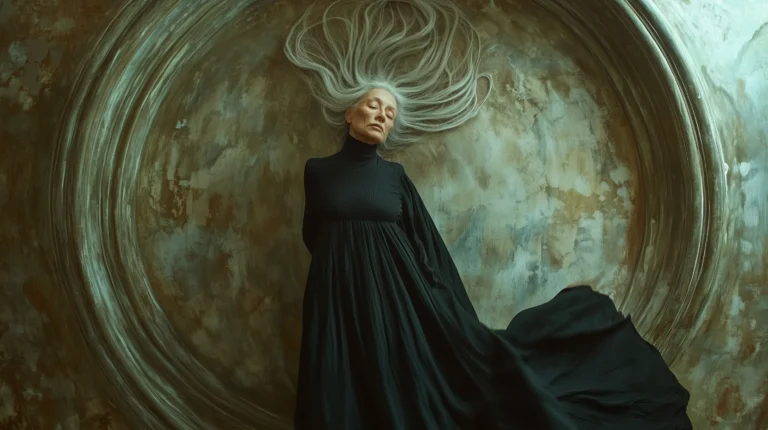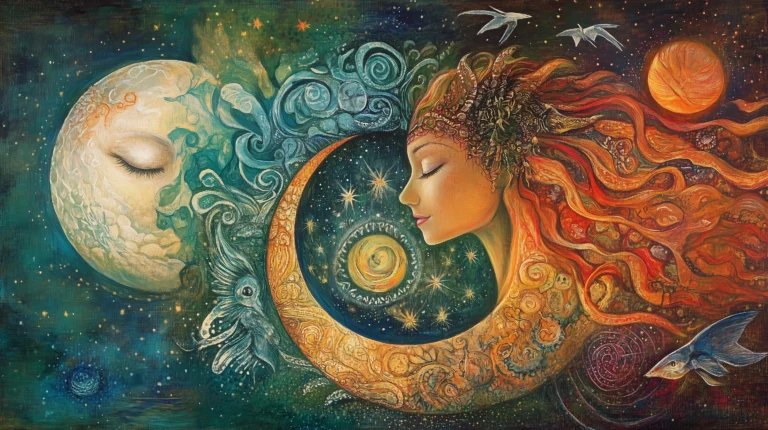The Tale of Kamar al-Zaman and Budur
The story of Kamar al-Zaman and Budur is one of the tales found in the collection of stories known as “One Thousand and One Nights,” also known as the “Arabian Nights.”
Kamar al-Zaman, whose name translates to “Moon of the Age,” is a handsome young prince, the only child of King Shahriman, who rules over the islands of Khalidan. Despite his father’s urgings to marry, Kamar al-Zaman stubbornly refuses, claiming that he has yet to find a woman who could match his beauty.
On the other side of the world, the same situation unfolds with Princess Budur, the daughter of King Ghayur, lord of China and the adjacent lands. She too refuses to marry, believing no man can match her beauty.
Back in Khalidan, King Shahriman, frustrated with his son’s stubbornness, has Kamar al-Zaman imprisoned in an old tower with a single window. One day, Kamar al-Zaman discovers a jewel box containing a ring. When he opens it, a jinni, Maymunah, appears.
Meanwhile, another jinni, Dahnash, arrives at Princess Budur’s palace and puts her to sleep. Curious, Maymunah flies across the world and meets Dahnash. They compare the beauty of Kamar al-Zaman and Princess Budur. After seeing both, they conclude that the two young people are equal in beauty. They undress Budur and place her next to the sleeping Kamar al-Zaman. When they wake up, they fall instantly in love.
However, they are separated again. Kamar al-Zaman wakes up alone in his tower, thinking it was all a dream, and falls into a deep depression. Budur, who thinks she dreamed of a man as handsome as her, is also heartbroken.
Their fathers, worried for their children’s health, decide to give in to their children’s apparent wishes. King Shahriman gives Kamar al-Zaman the kingdom, and King Ghayur disguises Budur as a man and makes her a king of a neighboring land.
As fate would have it, Kamar al-Zaman’s first act as king is to travel, and he ends up in Budur’s kingdom. Budur recognizes him from her dream and they confess their love for each other. Kamar al-Zaman buys a beautiful slave girl, Hayat al-Nufus, for his father to placate him, while Budur returns to her father with Kamar al-Zaman.
The tale of Kamar al-Zaman is full of trials, adventures, and separations, but in the end, Kamar al-Zaman and Budur are reunited and live happily ever after.
This tale is an excellent example of the themes of love, fate, and adventure that run through many of the stories in the “Arabian Nights.” It also reflects the cultural and societal norms of the time, including concepts of beauty, the roles of men and women, and the responsibilities of rulers.
The tale of Kamar al-Zaman and Budur, like many tales from “One Thousand and One Nights,” is filled with rich symbolism, mythic themes, and valuable lessons. Let’s delve into each:
Symbolism
The Ring: In many mythologies and fairy tales, a ring is often seen as a symbol of power, commitment, and eternity due to its circular shape. In this story, the ring is a catalyst, it summons Maymunah who orchestrates the meeting of the two lovers, Kamar al-Zaman and Budur.
Dreams: In this tale, dreams serve as symbolic bridges between reality and the subconscious mind, often foreshadowing future events or symbolizing deep desires or fears. The vivid dreams Kamar al-Zaman and Budur have of each other represent their innermost desires for an equal partner.
Myths
The Jinni: The Jinni in this story reflects common elements of Arabian and Islamic mythology. These supernatural creatures have the power to alter reality and human fate. They orchestrate the meeting of Kamar al-Zaman and Budur, thus demonstrating their function in myth as agents of change and catalysts for the story’s events.
Lessons
Love and Pride: Kamar al-Zaman and Budur initially refuse to marry because they believe no one can match their beauty. Their pride prevents them from finding love. The story suggests that pride can be an obstacle to happiness, and it’s only when they are humbled that they can fall in love.
The Power of Fate and Destiny: Despite the many trials and tribulations they face, Kamar al-Zaman and Budur are destined to be together, reflecting the idea that fate and destiny play powerful roles in human lives.
The Transformative Power of Love: The story also teaches the transformative power of love. Both Kamar al-Zaman and Budur change throughout the story, becoming less self-centered and more compassionate. Love is presented as a force capable of instigating personal growth and transformation.
Conclusion
The story of Kamar al-Zaman is a classic love story that emphasizes the importance of humility, the transformative power of love, and the concept of destiny. It teaches that love is not just about physical beauty, but also about understanding and respecting one’s partner. It also suggests that true love is destined and can overcome even the most challenging obstacles.
In realms where jinn and humans reside,
There lived a prince, in his beauty, he took pride.
Across the world, a princess fair,
Both lost in mirrors of self-despair.
No match found they in their global quest,
In love’s sweet game, they dismissed the rest.
Until a dream in deep night’s fold,
Brought a tale of love to be told.
Two hearts met in the dreamscape’s dance,
In sleep’s embrace, they found romance.
Awakened alone, hearts became stone,
Yearning for a love, they’d only known.
A journey began, each became king,
For love, oh the changes it can bring.
In fate’s kind hand and destiny’s weave,
The lovers met, their sorrow to relieve.
Mirror images in each other’s eyes,
In love’s sweet union, the true prize.
For love is not mere beauty’s reign,
But hearts in sync, feeling the same.
From the tale of star-crossed love so grand,
We learn to let pride’s veil disband.
To see not just with the outer eye,
But the heart’s gaze, which will never lie.
In Kamar al-Zaman’s enduring tale,
Let love’s transformative power prevail.
A dance with destiny, a fateful twirl,
In love, find the moon’s eternal pearl.







